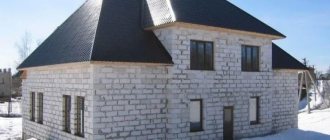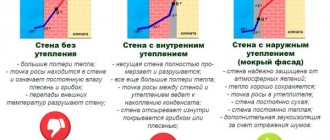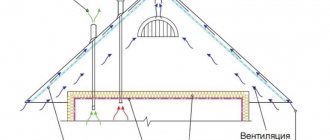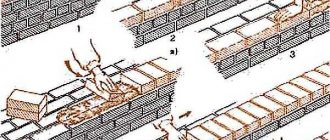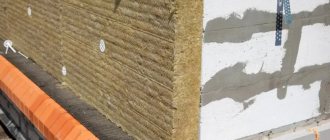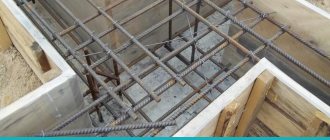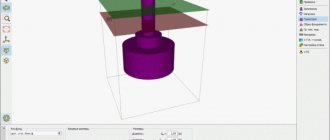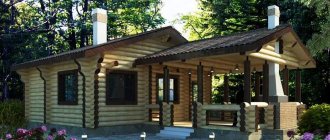This allows you to completely isolate the interior from the penetration of cold. Thermal insulation is a guarantee that the heat will remain inside the house, and heating costs will be significantly lower.
Pros and cons of foundation insulation with polystyrene foam
Advantages of the material:
- low thermal conductivity, good thermal insulation properties;
- frost resistance;
- almost no vapor permeability;
- water resistance;
- ease of processing;
- light weight;
- ease of installation: no careful leveling of the base is required;
- affordable price.
Flaws:
- flammability from G1 to G4. When finishing protruding parts (basement, etc.), external cladding with non-combustible materials is necessary;
- combustion toxicity;
- to avoid damage by rodents, it is necessary to install reinforcing mesh on top of the slabs;
- The material itself is waterproof, but does not provide the necessary waterproofing. In combination with insulation, treatment with waterproofing materials is required;
- It is necessary to protect the material from mechanical damage with asbestos-cement or reinforced concrete slabs and wooden panels.
Preparatory stage
Expanded polystyrene PSB-S
First you need to calculate how many insulation boards will be needed for the foundation. The dimensions of a standard polystyrene foam board are 600x1200 mm, thickness from 20 to 100 mm. For the foundation of a residential building, slabs 50 mm thick are usually used, laid in two layers. To find out how many slabs will be needed, the total length of the foundation is multiplied by its height and divided by 0.72 - the area of one sheet of polystyrene foam.
For example, if a 2 m high foundation is insulated in a 10x8 m house, the thermal insulation area is equal to 72 square meters. Dividing it by 0.72, we get the number of sheets - 100 pieces. Since the insulation will be carried out in two layers, it is necessary to buy 200 slabs 50 mm thick.
This, however, is a very average calculation, based on the fact that the insulation thickness will be exactly 100 mm. But this value can be greater - it all depends on the climatic conditions of the region, the foundation material, and the type of insulation.
There is a special system for calculating thickness, which requires knowing the R index - this is a constant value of the required heat transfer resistance established by SNiP for each region. You can check it with your local architecture department, or take it from the table below:
Calculator for calculating the thickness of foundation insulation
In order not to bother the reader with calculation formulas, below is a special calculator that will allow you to quickly and accurately find the required thermal insulation thickness. The result obtained is rounded up, leading to the standard thickness of the panels of the selected insulation:
Go to calculations
In addition to polystyrene foam you will need:
- mastic or roofing felt;
Ruberoid
- gravel;
- glue;
Adhesive for polystyrene foam
- mushroom dowels;
Fungus dowel
- putty or polyurethane foam;
- level;
- notched spatula;
- cement mortar;
- sand;
- reinforcing mesh;
Reinforcing mesh
- roller
When all the materials have been prepared, a trench is dug along the perimeter of the foundation. You need to dig to the freezing level, that is, to a depth of 1.5-2 m. To make it convenient to work in the trench, its width should be 0.8-1 m. Of course, soil excavation is carried out exclusively by hand, since equipment can damage the foundation. The walls of the base must be thoroughly cleaned of soil, unevenness and cracks must be repaired with mortar.
Calculation rules
The size of the insulation layer will depend on the type of building (residential, non-residential, heated or not), type of foundation, climate zone, and thermal insulation system used. The calculation is carried out according to the method “Thermal protection of buildings” SP50.13330.2012.
There are many options for determining the thickness of foam plastic, but they are very complex. It is better to use the online calculator offered by construction sites. You can use the formula:
R= df/λ b +dу/λ p , where:
- df - foundation thickness;
- dу is the thickness of the insulation;
- λb is the thermal conductivity coefficient of the foundation material (concrete or others);
- λп — coefficient. thermal conductivity of the insulation (indicated on the packaging);
- R - heat transfer resistance (value from the table).
The values of R, λ p, λ b are taken from the tables, the value of df is known, it remains to determine dу by substituting all the numbers into the formula:
dу = (R - dф/λb) x λп
The result is rounded. You can independently calculate both the thickness and width by substituting data from the tables (the values are determined for each value).
By dividing the areas of insulation and slabs, determine how many pieces are needed. In this case, 10-15% is added for adjustment. To protect the basement from the inside, use polystyrene foam no thicker than 3 cm.
Preparation and waterproofing
The preparatory process has its own nuances for each type of foundation. A “tape” of standard depth should be manually dug into a trench up to one meter wide and to the freezing depth. No technique is used in this case, so as not to accidentally “injure” the foundation. The surface is cleaned and leveled - the protrusions are chipped off and cracks are sealed with cement.
Waterproofing
Then a waterproofing layer is applied: bitumen mastic using a roller or liquid rubber from a spray bottle
It is important that the waterproofing material is applied in a continuous layer and does not contain organic solvents that have a destructive effect on XPS
Even more effective protection for strip foundations will be provided by a combination of bitumen and rolled material. Ruberoid, fiberglass, etc. are applied to the mastic in a heated state with an overlap of up to 150 mm, the joints are coated with bitumen. In the same way, a slab foundation can be insulated from moisture.
If the foundation is on stilts
With a pile foundation, a combination of a waterproofing compound and a drainage system is required to protect against groundwater. The drainage is installed in the following sequence:
- a shallow trench is dug;
- the bottom of the trench is covered with crushed stone;
- geotextiles are laid on top of the crushed stone;
- pipes for drainage of water are laid at an angle from the house;
- on top of the pipes there is another layer of geotextile;
- a top layer of crushed stone is laid.
What is extruded polystyrene foam
Not everyone clearly understands what polystyrene foam actually is. In general, this is nothing more than ordinary and well-known foam plastic, used in everyday practice, mainly for packaging fragile items. This is a durable, lightweight, heat-saving, biodegradable and almost insoluble material obtained by filling styrene granules with gas and then heating them.
When exposed to temperature, the granules “swell” until they occupy the entire volume available to them and sinter together.
Extruded or extruded polystyrene foam is distinguished by a special manufacturing technology. For ordinary polystyrene foam, polystyrene granules are simply heated with water vapor, while to obtain EPS, several processes are used at once: the granules are mixed and heated, a foaming agent is introduced, and then extruded under high pressure, i.e. pushed through the molding hole.
This technology provides greater uniformity and, therefore, greater strength of EPS compared to foam plastic.
A little about the product
Extruded polystyrene foam is an analogue of foam plastic, consisting of small edges. Production involves foaming the material using agents, which can be freon or carbon dioxide. Numerous tests have confirmed the negative impact of the former on the Earth's ozone layer. In this regard, manufacturers are increasingly trying to produce polystyrene foam using CO₂. The granules themselves are obtained by passing the mixture through a special matrix with small cells. As a result, finished sheets and panels are formed. This form was not chosen by chance, since laying extruded polystyrene foam in the form of small slabs is much easier and more convenient.
Basement insulation with penoplex
Technology for insulating the base in the same plane as the walls of the house:
- Marking. Since the insulation boards should be several centimeters higher than the waterproofing layer, horizontal markings should be made with a pencil along the entire surface of the wall.
- Cleaning the outside of the wall. The wall surface is pre-prepared for gluing with polystyrene foam. To do this, it is thoroughly cleaned from the outside of dust and dirt. After this, the surface is primed. After the primer has dried, you can proceed to the next step.
- Connecting slabs. Pasting the walls of a house with polystyrene foam is done using special glue, starting from the corner. The slabs are marked and cut with a sharp wallpaper knife.
- Applying glue to the wall and slabs. Using a special notched trowel, the adhesive is applied to the surface of the base. Pre-prepared fragments of slabs are smeared with glue and attached to the wall, the joints between the slabs and the ends outside the house are carefully sealed.
- Next, using a hammer drill, dowels are drilled and inserted, followed by driving in nails. After covering the entire surface of the outside of the house with slabs, a special primer layer is applied to provide the basis for all subsequent layers.
- Strengthening the slope angle. A metal corner is attached around the entire perimeter of the wall. For installation, the same adhesive is used as for the slabs.
- Installation of reinforcing mesh. The reinforcing mesh is pre-cut to the size of the slabs, lubricated with adhesive and glued on top of the polystyrene foam. The technology for strengthening the reinforcing mesh is the same as for installing the corner.
- Finishing work and installation of drip linings. Materials for external work are used to putty the base area. It is left to dry and primed again followed by painting. To prevent moisture penetration, flashings are installed.
Technology for insulating the base with polystyrene foam
If coating defects occur, they can be easily eliminated by re-priming and painting. The technology of thermal insulation with foam plastic is the same as that of penoplex.
The optimal way to attach insulation to the wall from inside the house
The most convenient and less expensive method of fastening is fastening with glue. The possibility of abandoning the mechanical method was discussed above - small areas and the absence of unfavorable climatic factors.
This work can be carried out in several steps over two days:
- Preparing the wall surface. The quality of the entire work depends on the basis on which the insulating material rests. The quality of surface preparation determines how firmly the foam will stick to the wall and how much glue will be needed to attach the sheets. The wall must be carefully leveled and primed. The surface of the foam, on the contrary, should be rough for better adhesion to the glue.
- Selection of the optimal adhesive for attaching foam sheets to the wall. Dry glue mixture or polyurethane foam glue? It all depends on the skills at work. It takes much more time to properly prepare glue from a dry mixture, and the quality and consistency of the glue must be constantly monitored. Laying insulation sheets using polyurethane foam is faster and the adhesion is better. But the complexity of preparing glue and the long duration of the work itself are compensated by the absence of errors with little experience in this field. Foam dries faster and requires experience and skill from the master. An important factor is that polyurethane glue in cylinders is much more expensive, and the quality of adhesion for glue made from a dry mixture is not much lower.
The glue is applied to the foam sheet using a notched trowel evenly over the entire surface in a layer of about 1 cm. The sheets are glued to the wall starting from the bottom to avoid slipping while the glue is drying. It is advisable to arrange the foam sheets in a checkerboard pattern, as when laying bricks. This way the whole structure will be more stable. Gaps should be minimal. If foam is used, glue is applied around the perimeter of the sheet at a short distance from the edge and in the center. After gluing, the gaps between the sheets are filled with the same glue and puttied.
After the glue has dried, mastic is applied to the insulation and a reinforcing mesh is laid on it. The mesh should be recessed in a layer of mastic; this will give greater stability to the entire structure and facilitate further work on the wall. The use of mastic and reinforcing mesh further strengthens the entire structure on the wall. Plastering does not relate to the process of attaching foam plastic to the wall, but this is the logical completion of the entire process.
For all the work you will need:
- The sheets of polystyrene foam themselves are of the required area.
- Dry adhesive mixture at the rate of 3 kg per 1 m2 of wall area. 1 bag contains 25 kg of dry mixture. If you decide to use foam, 1 can replaces one bag of dry glue.
- Reinforcing mesh, mastic (consumption of the finished mixture is 2-3 kg per 1 m2).
- Spatula, trowel, level and a classic set of home craftsman tools (hammer, screwdriver, knife, ruler, compass, masking tape).
- Electric drill if you are going to fasten with dowels.
The use of expanded polystyrene for home insulation has its supporters and opponents. Modern developments of this material make it possible to use it for residential premises without fear of adverse effects on health. Lightness, environmental friendliness and fire safety in addition to ease of installation make this material very competitive in construction and renovation.
Expanded polystyrene as EPS or XPS insulation
Today, mainly two types of expanded polystyrene are used as thermal insulation: foamed (EPS) and extruded (extruded, XPS). They differ not only in production technology, but also in properties. For foundation insulation, it is preferable to use XPS. Compared to it, EPS has a higher heat transfer coefficient (less effective as a thermal insulation material), is hygroscopic, and less durable. But at the same time, foamed polystyrene foam stands out for its comparatively low price. Its shortcomings can be mitigated by installing an additional layer of waterproofing that protects the material from wet soil, as well as foundation drainage, which helps lower the groundwater level.
Horizontal installation method
Slab foundation insulation scheme
Horizontal insulation is used for slab and strip foundations, for which polystyrene foam up to 10 cm thick is used.
Step 1. First, the site is cleared of soil, leveling the bottom, the last few centimeters are removed manually.
Step 2. The base is covered with sand, which needs to be compacted.
Step 3. Temporary formwork is performed, which is filled with a layer of concrete without reinforcement.
Step 4. Then, when it hardens, laying the slabs begins.
Step 5. A thick film is placed on top as waterproofing, which is glued with tape.
Step 6. Formwork is made, then reinforcement is made and the foundation is poured.
Step 7. When the formwork hardens, it is removed and additional thermal insulation of the side walls is performed.
Installed insulation
Video - Monolithic slab foundation. Insulation and waterproofing
Video - Monolithic slab - technology
Insulation of the foundation from the outside with polystyrene foam
The foundation of the house, as is known, directly interacts with the external environment, as it is located on the ground. Therefore, just like waterproofing, foundation insulation is an important stage in construction and repair work, on which the comfort of housing during the cold season will depend. In addition, thermal insulation is of great practical importance, since it prevents the penetration of dampness into the basement floors and does not allow the resulting condensation, which appears due to the temperature difference between the outside and the inside of the house, to adversely affect the laid communications and the supporting structure as a whole.
Foundation insulation scheme.
There are varieties of this material, for example, penoplex or expanded polystyrene, but in essence these are identical insulation materials, therefore the same technology is used to thermally insulate a strip foundation.
Due to the fact that such insulation is produced in the form of slabs with ready-made grooves, the installation of this material is very simple, and provided that you have construction skills, any adult can cope with this. The heat insulators listed above have the property of not being exposed to water, so the slabs do not deform.
It should be noted that insulation of the base can be done both from the inside and outside. The choice of option depends on many factors. So, if it is planned to insulate the foundation from the outside, then this will allow it to be laid to a shallower freezing depth, which reduces the costs allocated for building a house. In addition, in the case when the building stands on heaving soil, thermal insulation of the supporting structure from the outside will neutralize the impact of sub-zero temperatures on it, which will prevent movement of the foundation, and this greatly affects its durability and strength.
Also, having carried out insulation in this way, this material will serve as additional waterproofing. In other words, this option is the most optimal. Now, having understood all the nuances and decided on the material, before starting work, it is necessary to study the process of insulating the foundation from the outside with either polystyrene foam, penoplex, or expanded polystyrene. Let's look at everything in order.
Scope of application
EPPS is used in civil and industrial construction, greenhouse farming, in household appliances, in the construction of highways, runways, and pipeline laying. In the construction industry, EPS is used to insulate all house structures: from the foundation to the roof.
EPPS is one of the best materials for insulation
Insulation of foundations for almost all buildings in Russia is a necessary measure. According to the climatic zoning map, only in the southern regions of the Russian Federation can one do without this work. In the rest of the area, thermal insulation of the foundations must be carried out, and the further north you go, the larger the layer of insulation must be laid.
Since expanded polystyrene is produced in sheets, it is convenient for thermal insulation of all types of foundations - strip, pile, slab.
Moreover, the strip foundation can be insulated both from the inside and outside. For ease of installation, polystyrene foam sheets have a groove along the edge. For strip foundations, in addition to insulating the foundation itself, insulating the blind area is also important, especially on heaving and moist soils. Therefore, first of all you need to take care of drainage.
Types of expanded polystyrene
There are two main types of this insulation on the modern building materials market: foamed and extruded polystyrene foam. Let's take a closer look at them.
Extruded polystyrene foam
This material is also designated by the letters XPS. It should be noted that this type of coating has slightly better qualities, and therefore many people prefer to use extruded polystyrene foam to insulate the foundation. Its main advantages include:
- good ability to retain heat;
- high level of compressive strength, this indicator for this material varies within 0.25-0.5 MPa with surface deformation of 10%;
- extruded polystyrene foam has a uniform porous structure, and its pores are closed, which ensures good water-repellent function of the material;
- due to the fact that such a coating does not absorb moisture, it is not susceptible to freezing;
- Another advantage of this insulation is its durability; according to some manufacturers, the service life of the material is about 50 years.
Expanded polystyrene foam
It is also called polystyrene foam and is designated by the letters EPS. This material is also often used as insulation for foundations. Like the previous type of coating, foam plastic has a low level of thermal conductivity. Among its main advantages is its low cost, however, in terms of its qualities, EPS polystyrene foam is significantly inferior to XPS polystyrene foam. The difference between these types is as follows:
- Polystyrene foam can absorb a significant amount of water, which reduces its thermal insulation properties. Because of this, after covering the foundation it is necessary to create an additional waterproofing layer.
- The compressive strength of expanded polystyrene foam is 3 times lower than that of its extruded counterpart. In this regard, there is a need to protect the coating from soil pressure.
Taking into account the above characteristics, the technology for insulating the foundation with expanded polystyrene foam should include the following types of work:
- creating a waterproofing layer of bitumen, rolled roofing felt or any other suitable material on top of the insulation;
- erecting a brick wall around the foundation or covering the structure with profiled polyethylene membranes.
Advantages
Polyurethane foam, polystyrene foam, foam glass and expanded clay are suitable for insulating the foundation. The best is polyurethane foam, but it is more expensive and requires a spraying unit. Among expanded polystyrene foams, the advantage is on the side of EPS.
EPPS has many advantages
There are several reasons for this:
- good thermal insulation properties. Thermal conductivity is at the level of polyurethane and is 0.029-0.031 W/m*ºС. Moreover, in a humid environment these properties practically do not change;
- low vapor permeability – 0.005 mg/m*h*Pa. This is not enough for walls, but just right for the foundation;
- minimum water absorption – 0.4%. The walls of the basement and foundation will be dry;
- compressive strength and bending strength are quite high compared to other foams;
- frost resistance – more than 50 cycles. It is used at temperature differences from -70 to +75;
- durability – declared service life is 45 years;
- ease of use. Absolutely light, with a special edge, sheets that can be cut with a knife.
Extruded polystyrene foam is competitive in terms of price. However, it is always worth remembering that EPS is flammable, so you should try to use it outside in places with minimal risks of ignition, and also be sure to insulate it with non-flammable material.
Insulating the foundation using polystyrene foam
Polystyrene foam is not capable of collapsing when in contact with asphalt or paving slabs.
Among the many insulation materials for foundations, including mineral wool, glass wool and expanded clay, the most suitable material should be noted - polystyrene foam. Due to its ability to maintain its functions in any climatic conditions, the product has gained incredible popularity among builders.
The characteristics of polystyrene foam are reliability, low cost and ease of use. In addition, its main component is air, which itself has excellent thermal insulation properties.
Foam plastic for foundation insulation has the following properties:
- stability when interacting with asphalt and concrete;
- resistance to water and fire;
- ability to retain heat;
- resistance to temperature fluctuations;
- maintaining shape and volume when exposed to external factors.
A significant disadvantage of polystyrene foam is fragility. To prevent the formation of various defects on it, the surface should be treated with glue.
Polystyrene foam is recommended for insulation of foundations built on clay soil. In addition, it is an excellent insulation option designed for underground use. This is due to its good moisture resistance and resistance to sudden temperature changes.
Types of foam plastic for insulating the foundations of houses:
- press - plate, foam thickness - from two centimeters;
- tiled polystyrene foam, parameters – 1*1*0.05 m;
- polyurethane foam (liquid);
Most often, foam is used for insulation. The reason for this choice is its size, which has a beneficial effect on installation and finishing procedures.
Foundation insulation process
Selection of slab thickness
Today, slabs of material of various thicknesses are available for sale, this figure ranges from 3 to 12 cm. To decide which option is best for you, you should consider some factors, including:
- purpose of the basement, if any;
- the material from which the foundation and basement are made;
- thickness of the basement walls;
- the prevailing climate of the area in which the building is located.
For example, if a house is built in the middle zone and has a basement, then it is best to use extruded polystyrene foam about 5 cm thick for insulation. In the case where it is planned to create a sauna or living area in the basement, it is better to give preference to slabs 10 cm thick. I should also add that the corners of the building freeze the most, so in these places the foundation needs to be insulated with a thicker layer of material.
Work process
Insulating the foundation with polystyrene foam from the outside consists of the following steps:
- The first step is to dig a foundation around the entire perimeter of the house. The depth of the trench should reach the lowest point of the base, and the width of the hole should be such that it is convenient to work in it.
- Adhered soil, fragments of building materials and other debris should be removed from the surface cleared of soil. It is desirable that the wall be as flat as possible. If there are overly noticeable protrusions or depressions on it, they need to be eliminated.
- The next step is to waterproof the foundation. It can be made from coating, roll or sprayed products - the option depends on your desire and budget.
- Determine the depth of soil freezing. If the lowest point of the foundation is below this indicator, then the distance from the base to the freezing line of the soil will need to be filled with sand. It is not necessary to insulate the wall in this place, but waterproofing will have to be done.
- After the foundation is protected from moisture, you can begin installing polystyrene foam boards. It is best to secure the elements using adhesive mixtures. As mentioned earlier, the use of compositions based on organic solvents and hot mastics is strictly contraindicated, since they damage the material and reduce its thermal insulation properties.
- The glue should be applied to the sheet of polystyrene foam pointwise. One fragment measuring 1x0.5 m will need to be smeared in 6-7 places.
- After applying the composition, the insulation must be pressed against the wall surface and held in this position for 30-60 seconds.
- It is best to start insulating the base from any lower corner, moving along the structure. If you plan to cover the foundation with several layers of material, then the second layer should overlap the previous one in a checkerboard pattern. This way you will close the joints of the first level of slabs and improve thermal insulation.
- The corners of the building should be insulated more carefully, because it is through them that the most cold enters the room. The layer of polystyrene foam in these problem areas should be somewhat thicker, so it is recommended to stick an additional piece of insulation on each side of the corner.
- The outer side of expanded polystyrene, as a rule, does not require additional treatment, unless the foundation protrudes above ground level. After the process of insulating the base is completed, the trench around the building must be filled with sand and earth. It is better to add soil in layers, gradually compacting it.
- If, in addition to the foundation, you are also insulating the basement floor, then it is better to fix the material using special plastic umbrella dowels - they will hold the slabs more securely than glue.
Insulation of the foundation with polystyrene foam, video:
Some nuances
When insulating the base with polystyrene foam or polystyrene foam with your own hands, you should take into account a number of other facts, failure to comply with which can lead to improper operation of the structure or its destruction. The main requirement is that when choosing thermal insulation, it is recommended to consult with specialists and determine the exact thickness of the slabs required for the specific region in which the property is located. For more information about insulating the base and blind area with extruded polystyrene foam, watch this video:
In addition, there are a number of other important details. Below are some of them:
- Insulation slabs located above ground level must be additionally fixed using disc dowels.
- When installing the drainage system, be sure to tilt it towards the storage wells, where moisture will flow through the pipeline.
- When insulating corners of the foundation, it is recommended to apply a double layer of thermal insulation, since these elements are considered the most susceptible to freezing.
- Extruded polystyrene foam and polystyrene foam cannot be glued to a composition containing acetone, ethyl acetate, toluene and white spirit.
- The work process must be carried out at positive ambient temperatures.
- Insulation of a high foundation is carried out with the thermal insulation arranged in a checkerboard pattern. The seams should not be located on top of each other. The use of a double layer is not recommended by professionals, who explain this by the fact that under soil pressure as a result of soil heaving, the layers can come apart and compromise the integrity of the structure. If you do use this option, make sure that the seams do not coincide with each other. This will help avoid the formation of cold bridges.
The main mistake of home owners is the desire to insulate the walls of the building, and not its base. At the same time, not many people are interested in thermal insulation of the foundation. Therefore, this leads to significant heat loss and a reduction in the service life of the base and the entire structure.
What you need to know about foundation insulation
Carrying out such work will allow you to achieve the following results:
- ensuring a comfortable stay in the room;
- reducing building heating costs;
- protecting the soil around the base of the house from swelling and freezing and, as a result, protecting the foundation and the building itself from destruction;
- creating comfortable conditions in the basement of the house, thanks to which the room can be landscaped and used for various purposes.
You should know that the material for insulating the foundation must have certain properties. Among the main requirements are the following:
- Low thermal conductivity, which will allow you to maintain an acceptable temperature in the room.
- Waterproof. If a material absorbs a lot of water, its thermal insulation properties deteriorate. In addition, moisture turns into ice in winter, which leads to damage to the insulation, its deformation and destruction.
- High strength. Since the material is used to insulate the part of the house that is underground, it will constantly be subject to soil pressure.
Is it possible to insulate the foundation with polystyrene foam?
Expanded polystyrene and polystyrene foam are synthetic heat-insulating materials, almost entirely consisting of air bubbles, which explains their extremely low thermal conductivity. Insulating the foundation with polystyrene foam is beneficial in many ways:
- low cost in comparison with analogues;
- low degree of water absorption;
- very wide operating temperature range;
- low density;
- availability of technology for insulating foundations with their help.
The disadvantages include only some fire hazard and modest mechanical strength
However, in practice they can be ignored, since the risk of fire on the outside of the foundation is extremely small, and it is very difficult to mechanically damage the material covered with decorative finishing or soil
Meanwhile, polystyrene foam and polystyrene foam have slight differences in characteristics:
- expanded polystyrene has one and a half to two times lower thermal conductivity;
- polystyrene foam is several times stronger than polystyrene foam when compressed;
- expanded polystyrene is somewhat heavier than polystyrene foam and has the property of vapor permeability;
Expert advice
Polystyrene foam is a fairly flammable material. To eliminate the possibility of fire, manufacturers use fire retardants. Polystyrene foam with fire retardants is marked FS.
When choosing expanded polystyrene and penoplex for insulating the foundation base, you need to look at the density of the material indicated in the marking. For foundation insulation work, polystyrene foam with a rating of 35 and higher is suitable.
Some homeowners choose to use penetrating insulation and insulation. Before using them, you need to consult with a specialist about the compatibility of this insulation with a certain type of foundation.
When insulating the entire base, it is worth leaving ventilation holes so that there is always fresh air in the interior. In winter, the holes in the base are plugged with special plugs. This will provide thermal insulation.
Insulating the base with foam plastic requires waterproofing and high-quality protection of the blind area using a layer of thermal insulation.
The need for thermal insulation of the foundation
Insulating the foundation of a basement
Insulating the foundation of a private house with polystyrene foam from the outside is mandatory. This also applies to other buildings, especially those containing a basement. To achieve high-quality results in installing thermal insulation, many use foam plastic.
A poorly insulated building loses up to 50 percent of heat through holes in the insulating coating, causing additional economic costs for heating. A fatal mistake when installing house insulation is neglecting the thermal protection of the foundation, believing that it will be enough to just finish the walls of the structure.
Good thermal insulation of the base is characterized by two functions:
- minimizing heat consumption;
- Preservation of the foundation from freezing and deformation.
The fact is that the predominant type of soil in our country is heaving. Due to the effects of cold, the depth of soil freezing can be several meters. During a thaw, the volume of soil changes, which in turn negatively affects the structure of the foundation of the house.
Before starting installation work, it is necessary to take into account that the installation of the thermal insulation coating must be complete. The presence of any cracks, defects and parts in the insulation layer has a detrimental effect on the building’s ability to maintain a temperature suitable for comfortable living. Only a dense air layer containing an insulation ball can completely contain the loss of warm air.
Installation of EPS
When the waterproofing is finished and the bitumen has finally cooled down, insulation of the foundation with polystyrene foam proceeds to the main stage. The thickness of the insulation is determined in accordance with the parameters of the foundation and the climatic characteristics of the region. For example, if the winter in the area where you live is harsh and long, it would be reasonable to lay the thermal insulation in two layers, five centimeters each.
Foundation insulation with extruded polystyrene foam
Expanded polystyrene sheets are available both corrugated and smooth. To ensure optimal adhesion to glue, the former are better suited. But if you nevertheless purchased smooth slabs, immediately before installation, treat them with a needle roller.
How to attach?
Fastening polystyrene foam below ground level requires the use of exclusively special glue that does not contain organic solvents. It is applied to the insulation with dotted strokes in the corners and in the center of the sheet. Then the insulation sheet should be firmly pressed against the foundation and held until the glue sets.
Under no circumstances should you fix the thermal insulation in the basement using dowels, as they will damage the moisture-resistant layer. Above ground, the sheets are attached to the wall with hardware three days after installation, when the glue has completely dried. Each sheet contains approximately five dowels, which are driven into holes drilled through the insulating material.
How to lay it?
EPS sheets should be laid from the corner of the house, checking the correct installation using a level. At the corners, it would be better to lay the material in two layers, with a meter extending in each direction from the corner. The slabs are mounted to each other using a connecting locking system at the edges. If there are gaps between the sheets, they are sealed with polyurethane foam sealant.
Thermal insulation protection
Thermal insulation must be protected from rodents and unexpected ground movements. There are two main protective technologies: using geotextiles and roofing felt or reinforced fiberglass mesh. The cost of the glue on which the mesh is attached is quite impressive, so it is permissible to use cement mortar instead.
Backfilling the trench
The trench dug around the perimeter of the house, after completing the insulation work, should be filled in only when all the materials are dry, including the cladding of the basement floor.
This process occurs in several stages:
- the bottom of the trench is covered with a layer of sand up to 150 mm thick;
- the sand should be moistened, leveled and compacted well;
- Expanded clay or gravel is laid on top of the sand layer, the layer thickness is from 200 to 300 mm;
- the excavated soil is poured on top of the gravel cushion and compacted very carefully;
- The trench should not be completely buried; approximately 300 mm should remain to the ground level for the blind area.
Do-it-yourself technology
Insulation of walls with polystyrene foam can be done independently, without special training or skills. There are the following methods of thermal insulation with foam plastic:
- Foam boards are attached to the wall, covered with a vapor barrier film on top, then a sheathing is made onto which finishing panels made of plasterboard or other materials are attached. In this case, careful treatment of the walls is not required; all defects are hidden under the finishing materials.
- The second method is less time-consuming and expensive, if the wall is smooth and does not require much leveling work. In this case, it is cleaned, processed, and the slabs are glued directly to the wall with a special mastic. Then finishing work is carried out.
Let's consider the second, simpler method.
Surface preparation
If the wall is painted and the paint layer is strong enough, then in this case you can simply clean the surface of dirt, fill cracks or uneven areas with putty, and treat it with an antiseptic to protect against the formation of mold. After this, you can glue the foam boards.
Alignment
When the wall is uneven and the paint is peeling off, you need to carry out the necessary work to prepare it:
- remove the entire paint layer;
- clean from dirt;
- level with plaster and putty;
- prime;
- treat with an antiseptic and only then glue the foam.
Insulation
Foam boards must be glued from the bottom row. Adhesive mastic is applied to each of them along the entire perimeter and a few more dotted strokes are made along the inner area. The slabs must be arranged according to the principle of brickwork, so that the vertical seam of the next row falls in the middle of the previous slab.
After 3 days, when the mastic has dried, you need to secure the foam to the wall with special fasteners with wide heads. There are 6 pieces for each slab (at the edges and in the middle). To speed up the work, instead of mastic, you can choose a special glue that dries in a few hours.
